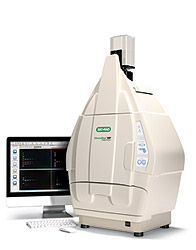Instant Visualization at Every Stage Reassures Researchers Throughout Immunoblotting Workflow
Hercules, CA — September 6, 2011 — Bio-Rad Laboratories, Inc. announces the launch of its ChemiDoc™ MP Imaging System, the industry's only stain-free enabled instrument capable of chemiluminescent, multiplex fluorescent, and routine gel imaging.
Using the stain-free detection option of the ChemiDoc MP system, researchers can quantify total protein for normalization purposes after transfer to the membrane. This stain-free total protein normalization method produces faster results and overcomes the potential errors associated with normalization using housekeeping proteins.
"I've found that using stain-free imaging with the ChemiDoc MP is as good as or better than using housekeeping proteins for normalization," said Aldrin Gomes, assistant professor at the University of California, Davis. "This also saves time and hassle since I don't need to reprobe the blot for housekeeping proteins."
Researchers quantifying western blot experiments traditionally normalize data with housekeeping proteins, which often requires stripping and probing the membrane a second time, or probing with multiple antibodies simultaneously. Stripping and reprobing adds extra steps to the protocol, consuming reagents, time, and labor. Alternatively, probing with multiple antibodies simultaneously requires reagent optimization over several experiments. Furthermore, a published report indicates that normalizing against housekeeping proteins might produce inaccurate results, depending on experimental conditions and sample types.
Assurance at Every Stage of the Western Workflow
The ChemiDoc MP system also integrates with Bio-Rad's V3 Western Workflow™, a portfolio of Bio-Rad products that shorten the protein separation and blot transfer steps from several hours to 30 minutes. In addition, the V3 Western Workflow offers researchers confidence in their western blot results, providing them a way to visualize their proteins at every stage of the protocol. Using the ChemiDoc MP system, researchers can visualize protein separation on Criterion™ TGX Stain-Free™ Precast gels, verify successful transfer with the Trans-Blot® Turbo™ transfer system by imaging the membrane using stain-free detection, and validate the accuracy of western blot results at every step.
Publication-Ready Images Made Easy
The ChemiDoc MP system makes it easy for researchers to acquire high-quality images in seconds, whether for chemiluminescence and fluorescence detection or for colorimetric gel and blot documentation. The ChemiDoc MP system remains in focus at any zoom level. This automated, hands-free operation ensures consistent, reproducible, and high-throughput performance.
"The time taken to get a picture with ChemiDoc MP is much faster than other instruments I've used," said Gomes. "Because of the autofocus feature, I can take publication-ready photos within ten seconds."
The ChemiDoc MP system delivers superior linearity and comparable limit of detection to film while delivering quantitative and reproducible data.
For product details please visit www.bio-rad.com/ad/mp.
About Bio-Rad
Bio-Rad Laboratories, Inc. (NYSE: BIO and BIOb), has remained at the center of scientific discovery for more than 50 years, manufacturing and distributing a broad range of products for the life science research and clinical diagnostic markets. The company is renowned worldwide among hospitals, universities, major research institutions, as well as biotechnology and pharmaceutical companies for its commitment to quality and customer service. Founded in 1952, Bio-Rad is headquartered in Hercules, California, and serves more than 100,000 research and industry customers worldwide through its global network of operations. The Company employs over 6,800 people globally and had revenues exceeding $1.9 billion in 2010. For more information, visit www.bio-rad.com.
For more information contact:
Ryan Short
Bio-Rad Laboratories, Inc.
800-876-3425
ryan_short@bio-rad.com
Ken Li
Chempetitive Group
312-997-2436 x 109
kli@chempetitive.com

